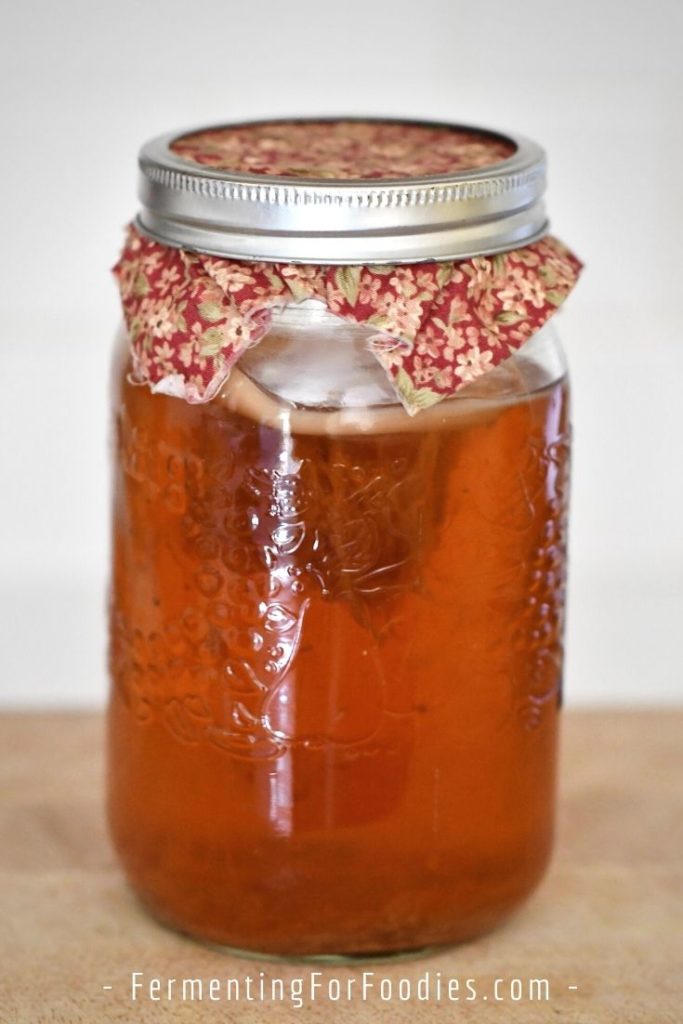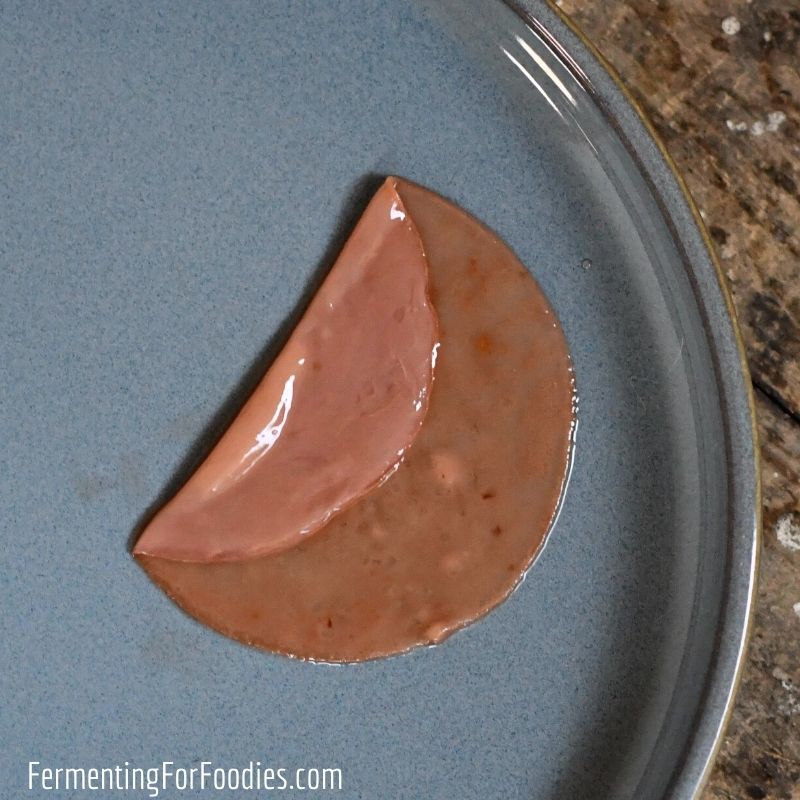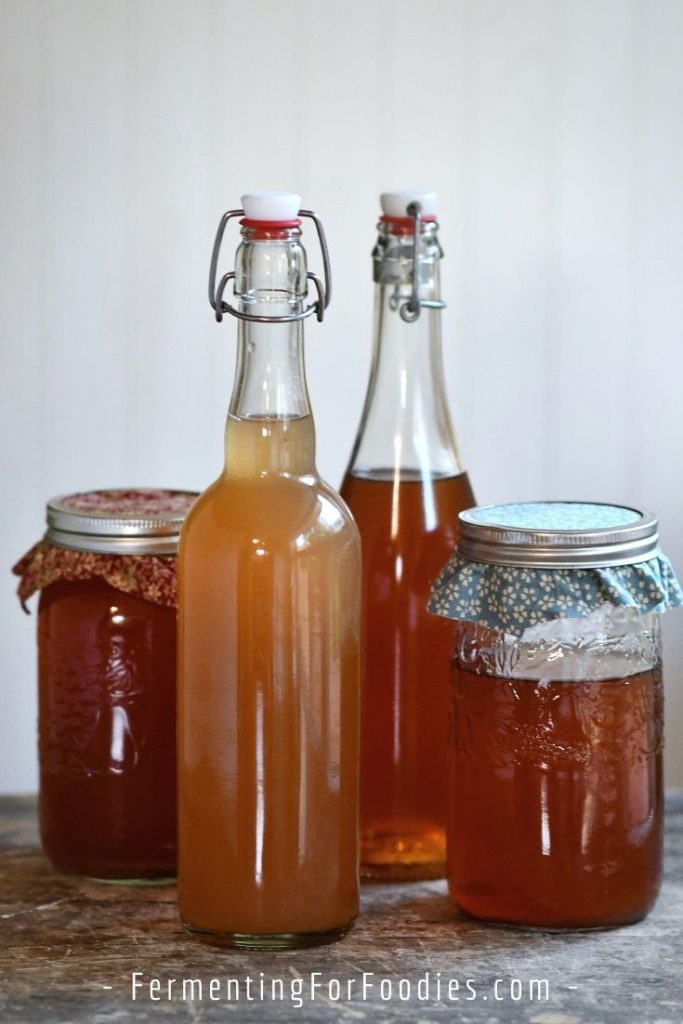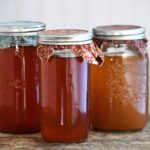Wine vinegar is a simple ferment, perfect for beginners. It’s an easy and delicious way to use up a bit of extra wine. Feel free to use your favorite wine or experiment with different fruit combinations!

My first experience with homemade wine vinegar happened quite accidentally. Brad and I were about to bottle a batch of plum wine and discovered that we’d forgotten to put water in an airlock of one of the carboys!
The wine definitely wasn’t off. It had no mold and it smelled fine. However, the color was much darker than the other 3 carboys of plum wine and the flavor was sour. Our wine had spontaneously turned into vinegar!
Types of vinegar
Vinegar is produced when acetic acid bacteria convert ethanol (alcohol) to acetic acid. This is an aerobic process. Meaning that the bacteria need oxygen to do their work.
So unlike other ferments, vinegar cannot be made in a closed, air-tight container.
There are actually a number of different ways to make vinegar.
- Spontaneous vinegar: Juice can spontaneously ferment into hard cider then vinegar. This relies on a bit of luck because mold and kahm yeast also enjoy spontaneously fermenting juice.
- Simple juice vinegar: Mixing juice with a vinegar mother will ensure a good ferment. It results in rich and flavorful vinegar.
- Fruit scrap vinegar: Fruit scraps mixed with water, sugar, and vinegar mother will ferment into a light-tasting vinegar. It’s a great way to use up leftover fruit peels and cores!
- Vinegar made from alcohol: Vinegar can be made from fruit wine, hard cider, rice wine, or beer (malt vinegar). Once the alcohol has finished brewing, all that’s necessary is to expose it to the acetic acid bacteria. Vinegar made from alcohol usually is the most acidic. This is because acetic acid is made from ethanol, which is highest in alcoholic ferments.

Deciding What Type Of Wine To Use
This recipe is perfect for any type of fruit wine.
Personally, I love making vinegar with homemade wine. It’s the best way to indulge in all sorts of fun fruit flavors, like peach, pear, and plum!
However, even moderately priced store-bought wine is cheaper than a bottle of high-quality wine vinegar.
Here are a few things to consider when choosing a wine for vinegar:
- High sulfite wines will stop or slow down the fermentation process. While most commercial wines include some sulfites, avoid any wines labeled as containing sulfites as they will contain very high amounts. Or avoid sulfites altogether by using homemade wine.
- The flavor of the wine will impact the flavor of the vinegar. Sweet wines will still have that bit of sweetness. The bacteria eat alcohol, not sugar.

How To Make Wine Vinegar
It is really easy to turn wine into homemade wine vinegar. All that you need is two ingredients and a bit of patience!
- Prep Time: 2 minutes
- Total Time: 2 minutes
- Yield: 3 1/4 cups 1x
- Category: Condiments
- Cuisine: Traditional
- Diet: Vegan
Ingredients
- 3 cups of wine (see above for options)
- 1/4 cup of apple cider vinegar with a mother (see notes)
Instructions
- Mix the wine and the vinegar mother in a glass jar. I don’t recommend using plastic or metal because they may react to the acidity in the vinegar. Shake the vinegar bottle before measuring to ensure that the vinegar is well mixed.
- Cover the jar with a cloth or coffee filter held in place with a rubber band or jar ring.
- Place the jar somewhere dark and at room temperature to ferment. I usually stash all my vinegar in a closet.
- Leave the wine to ferment for 2 months.
- At some point, the wine may smell bad, like nail polish remover. That is part of the process as ethanol is converted to acetaldehyde before turning into acetic acid.
- The vinegar is ready when it is sour. You can either use a kit to test the pH or taste it. If it’s sour then it’s ready to be bottled.
- Store finished vinegar in an air-tight bottle. I recommend letting it age for another month or two. While it won’t become more acidic, aging will help to develop the flavor.
- Homemade vinegar will last for years in a dark location. The flavor will likely continue to improve as it ages. (True balsamic vinegar is aged for over 12 years!)
Notes
- Wine may naturally ferment into vinegar, but adding a bit of acetic acid bacteria is definitely recommended.
- Make sure that the apple cider vinegar contains a mother. Look for brands labeled raw, unpasteurized, or with mother.
- Often a thick rubbery disk will form on top of the vinegar. It’s called a vinegar pellicle, and it is perfect for culturing future batches of vinegar. Save it and use it instead of the ACV.



Leave a Reply